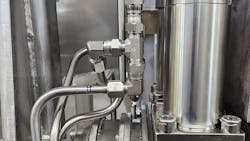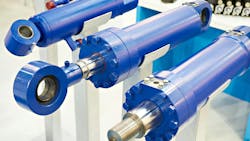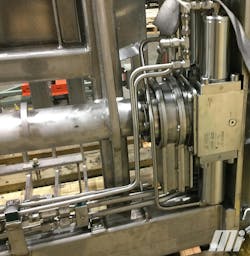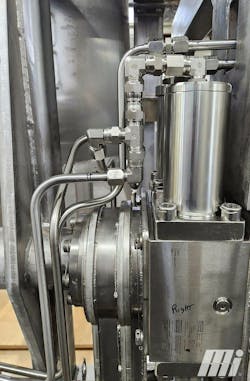System Redesign Optimizes Hydraulic Elevators for Heavy-Duty Drum Dumping
What you’ll learn:
- The challenges a food and beverage manufacturer was experiencing with its hydraulic elevator system.
- How the creation of a custom hydraulics system addressed the elevator’s performance and maintenance issues.
- Benefits achieved by redesigning the elevator system’s mechanical actuation and hydraulic control.
In industrial processing environments, handling and dosing large volumes of liquid or semi-solid chemicals into high-capacity blenders is a critical operation. For a global food and beverage manufacturer, this task became a significant engineering challenge.
Their fruit preserve processing system used a hydraulic elevator system designed to lift and pour the contents of two 55-gallon drums of preservative into a 40-foot-high blender. Reliant on linear hydraulic cylinders, the existing design experienced recurring mechanical failures and operational instability, posing safety risks and costly, unplanned downtime.
An engineering team from Motion Repair & Services identified this as an opportunity for the manufacturer to optimize its operations. They successfully addressed these issues by creating a custom hydraulic system that resulted in improved throughput and cost savings.
This case study explores the challenges encountered in the initial hydraulic elevator design and analyzes how success was achieved through innovative mechanical redesign and hydraulic circuit improvements.
Hydraulic Elevator Experiences Persistent Maintenance and Performance Issues
The original hydraulic elevator was tasked with lifting two standard 55-gallon drums filled with preservative up 40 ft. and tipping the contents into a blender situated at this height. To accomplish this, the system employed a pair of linear hydraulic cylinders to control the tipping action, rotating the drum carriage approximately 120 degrees into the blender.
Frequent mechanical failures occurred primarily due to the force vector dynamics of the linear actuators relative to the tipping action. The linear cylinders generated force along an axis misaligned with the rotational tipping motion required. This misalignment caused only a small component of the cylinder’s force to contribute effectively to tipping. The larger component of the actuator-generated force imposed significant loads on the bearing and torque tube assembly, which were not optimized to withstand these stresses. This led to premature mechanical wear and failure.
The net effect was inefficient force transmission, excessive stress on structural components, and frequent breakdowns that disrupted production.
Beyond mechanical failure, the hydraulic control system exhibited critical circuit problems, including uncontrolled hydraulic flow. Control-valve failures allowed hydraulic fluid to flow unrestricted, causing the elevator carriage to move abruptly or “catapult” during operation. This sudden, uncontrolled motion posed safety hazards and risked damage to the drums and equipment.
The other main issue was a lack of flow regulation and motion control. The original circuit was missing the components required to modulate the flow, speed and acceleration of the actuators. These are essential features for controlled and safe dumping operations, especially when handling varying product viscosities from liquids to solids.
Hydraulic System Redesign Addresses Performance Challenges
To address the challenges Motion’s customer was experiencing with its hydraulic elevator, the Motion engineering team initiated a comprehensive redesign focused on optimizing the elevator system’s mechanical actuation and hydraulic control.
Switching From Linear Hydraulic Cylinders to Rotary Actuators
The key advancement creating the “magic” was in the creation of a new circuit design. This involved replacing the elevator’s pair of linear hydraulic cylinders with rotary actuators specifically selected and configured to improve tipping force and motion.
Some advantages realized with the rotary actuators included:
- Direct Rotational Force Delivery – Rotary actuators provide torque directly around the rotation axis needed for tipping the drums. This alleviated the force vector inefficiencies seen in the prior system.
- Reduced Bearing Load – By delivering torque without relying on off-axis force components, the stress on bearings and torque tubes markedly decreased.
- Compact and Durable Design – Rotary actuators often have more compact footprints and fewer linkage parts than linear cylinders using complicated lever arms, reducing mechanical complexity and potential failure points.
The new carriage design integrated the rotary actuators precisely aligned with the rotational bearing assembly. This arrangement ensured three key things — smooth, controlled tipping motions with optimally applied torque; improved mechanical robustness through balanced loading; and simplification of mechanical linkages, reducing maintenance demands.
New Circuit Architecture Improves Hydraulic Flow Control
To resolve the uncontrolled hydraulic flow issues, the engineering team redesigned the circuit architecture, incorporating these key features:
- Proportional directional control valves, which allowed variable control over the fluid flow rate and direction, enabling precise control of actuator speed and position.
- Pressure relief valves and flow restrictors that were adjusted or installed to maintain controlled hydraulic pressures and prevent sudden surges.
- Hydraulic accumulators or dampers that absorbed pressure spikes, smoothing actuator motion where applicable.
Given the variability in product properties — from free-flowing liquids to viscous or partially solid preservatives — the system required the ability to modulate dumping speed and force accordingly.
The control system was upgraded to include PLCs (programmable logic controllers) to orchestrate valve positioning and actuator movement based on operator input or sensor feedback. Stroke and position sensors provided real-time data to ensure precise control of tipping angle and speed.
In addition, algorithms dynamically adjusted dumping parameters for each batch, reducing spillage and ensuring that the drums were completely emptied without damaging the contents.
Custom Hydraulic System Results in Performance Improvements and Enhanced Mechanical Reliability
The Motion team thoroughly tested the new custom hydraulic system mechanically and hydraulically before sending it for installation at the customer’s site. The results were equally successful during initial testing and once on-site.
After the redesign, the elevator carriage experienced no further mechanical failures related to actuation forces. Stress on bearing and torque tube assemblies decreased dramatically, extending their service life. Reduced mechanical complexity simplified routine inspections and maintenance.
Operational safety and precision also improved with controlled hydraulic flow, which eliminated sudden, dangerous carriage movements. Operators reported increased confidence in system response and predictability. The system accommodated variable dump speeds tailored to product characteristics, improving processing quality.
Over time, the rotary actuators in the carriage underwent further upgrades, including the use of improved actuator materials and seals that met stricter sanitary requirements typical in chemical and food-grade processing environments. Improvements in actuator components increased the carriage’s operational lifespan: Testing confirmed a 300% increase in carriage life, now exceeding 100,000 duty cycles with ongoing refinements.
This case study highlights the criticality of aligning actuator design and hydraulic control systems with the mechanical and operational demands of heavy-duty industrial equipment. For this food and beverage manufacturer, switching from linear hydraulic cylinders to rotary actuators optimized force transmission and dramatically improved mechanical reliability. Coupled with a well-designed hydraulic circuit incorporating motion control and safety elements, the redesigned elevator system made the preservative process more robust and repeatable.
This engineering approach provides a valuable blueprint for other industrial applications that involve heavy material handling, complex motions, and the need for precise, safe actuation over extended operational lifetimes. The collaboration between Motion and the food manufacturer brought efficiency and innovation to the facility’s process, making the results especially sweet.
This article was written and contributed by Jim Verona, Director, Engineered Solutions Group, and Scott Maher, CFPHS, Application Engineer Manager, Motion Repair & Services.
About the Author
Jim Verona
Director, Engineered Solutions Group, Motion Repair & Services
Jim Verona is Director, Engineered Solutions Group for Motion Repair & Services. He has 40 years of industry experience.
Scott Maher
Application Engineer Manager, Motion Repair & Services
Scott Maher, CFPHS, is an Application Engineer Manager for Motion Repair & Services, with over 20 years of industry experience.

Leaders relevant to this article:



